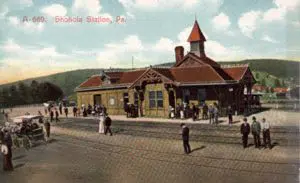WELCOME TO THE SHOHOLA GLEN SWITCHBACK GRAVITY RAILROAD HOME PAGE.
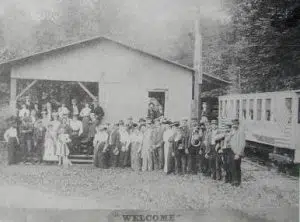
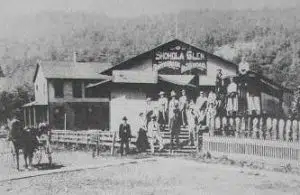
The picture on the left is looking up the lift plane in 1908 just after the abandonment of the switchback railroad. The Picture on the right is how the lift plane appears today. The road is in the same location in both pictures. To the careful observer, there are remains of ties, spikes, rails, trestle foundations and even the 150 year old iron cable that pulled to coaches up the lift plane. I believe the stones in the center of this picture I took in 2002 are remains of the lower track as it crossed the road. You can also see the construction of the new community playground and park just around the corner on the right side of the road. Unfortunately the recent construction has removed any remains of the lower track in this area. I hope that a plaque or monument will be placed in the park recognizing the original resort and gravity railroad. Fortunately, the lift plane on the other side of the road remains undisturbed.
This is how the Shohola Glen Switchback Gravity Railroad plane lift appears today.This is how the Shohola Glen Switchback Gravity Railroad lift plane appeared just after abandonment in 1908.
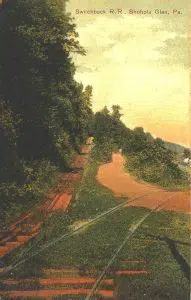
The railroad was constructed on a gauge of 4 foot 3 inches, using track, four coaches and cables salvaged from the Pennsylvania Coal Company Gravity Railroad which had closed a year earlier after being replaced by a standard gauge Wyoming Division of the Erie Railroad.
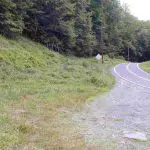
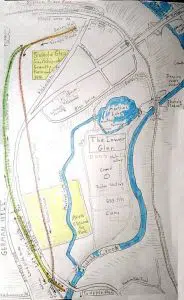
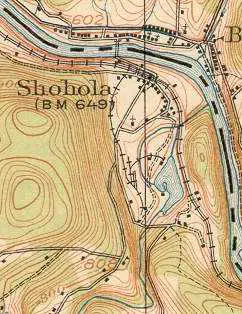
The survey map on the right is dated 1935 and shows the relocated rails running to the mill. You can see a number of sidings to allow freight cars to be shuffled by a small steam locomotive purchased from the recently abandon, Delaware and Hudson Gravity Railroad depot in Honesdale. Lumber had to be removed from the flat cars of the Shohola Glen Railroad and reloaded onto Erie Cars.
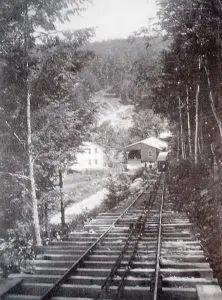
The Photograph on the right, also taken in 1886 and shows the coaches “Dobson” and “Pioneer” stopped on the trestle on the way to Shohola Village.
You can view the preserved Pennsylvania Coal Company Gravity Railroad Coach, “Pioneer” in Hawley, Pennsylvania.
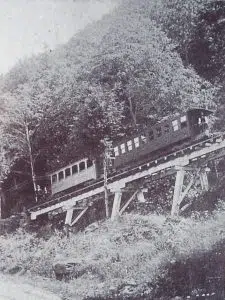
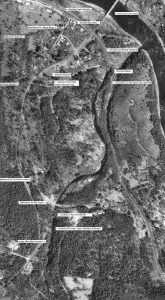
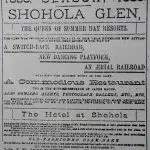
Unfortunately he never saw is dream come to fruition as he died in 1882 of a stroke before any part of the “Queen of Summer Resorts” was built. The property was sold to the “Blue Stone King” John Fletcher Kilgour in 1882, who developed the site into prominence as an unrivaled wilderness summer resort.
In the lower glen, Kilgour constructed a large lake, pavilions, galleries, amusement rides including a carousel, a huge dancing and roller-skating platform under the Shohola Viaduct on the Erie Railroad, and a large dining hall and kitchen. He also convinced the Erie Railroad to place the caboose that Commodore Perry used for shelter during his exploration of the Arctic.
In the upper glen he constructed paths and rustic bridges across the Shohola Creek and through out the park to showcase the natural beauty of the Glen. Pools of water and formations named Cascade Cavern, Bell Rock, Devil’s Pass, Hell Gate, Terror Grotto, Satan’s Nose, and The Spirit of Dark Waters were some of the names given to these places of natural beauty. He also constructed an “Aerial Tramway” that spanned the glen at a height of more than 100 feet above the Shohola creek. This was probably the first “cable car” ever constructed and was also water powered. It sloped toward the mill and only required power to move the car in the opposite direction.
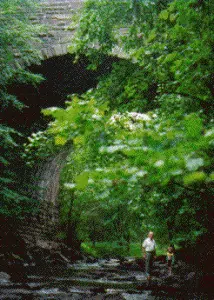
Some of the outings at the Glen were wild and raucous. A group of coal miners from the Scranton area arrived on a thirty cars excursion train. When a sudden Pocono thunderstorm rained down, the large boisterous, inebriated crowd overturned stands, stole money and goods, and damaged park property. With swinging sticks they turned on the manager who escaped to the Shohola Glen Hotel with a large money bag of the day’s receipts. Gambling and drinking occurred frequently in the Glen when the park was reserved by private groups and gave the Glen a bad reputation locally. The Pioneer and the Dobson, two coaches purchased by John Kilgour from the Pennsylvania Coal Company Gravity Railroad for use on the Shohola Glen Switchback Gravity Railroad.
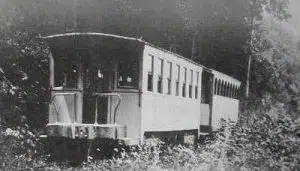
This link will take you to a file of many other photographs, drawings and maps of the Glen and gravity railroad.
Please join the Pennsylvania Gravity Railroads discussion group.
In eighty years nature has reclaimed the Glen and very little remains of the park or sawmill. The Gravity RR coach “Pioneer” was preserved and resides in Hawley, the eastern terminus of its original run.
The steep rocky walls of the Glen exceed 500 feet in places and the natural beauty of the park was arresting. During the peak years the park attracted almost 10,000 visitors per day. There were more than 80 hotels and rooming houses in the area for overnight guests. The park was lighted by colored electric lights, lanterns and electric torches with power being generated on site from a turbine in the old mill. A similar 100 year old turbine exists along the creek in nearby Greeley. Check the link at the bottom of the page for pictures and descriptions.
There are many legends that John Kilgour created or expanded upon to attract visitors to the park. One tells of a silver mine used by the Lenni Lenape Indians that had an entrance in the Glen. It opened into subterranean caverns and extended more than a mile to an exit near the Panther Creek north of Shohola. My son Jonathan and I searched for the entrance to the cave. We found many small caves through out the upper glen, but unfortunately no silver mine. Another legend tells of a large rock called Lover’s Leap where a distraught Indian maiden jumped to her death. One large flat stone known as the Shohola Stone was considered by the Lenni Lenape to be the center of the universe and provides super natural powers to all who stand on the stone.
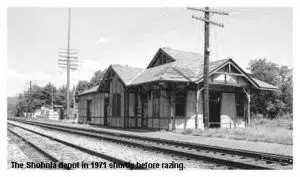
Hundreds of injured and dead soldiers ware brought here on on July 15, 1864 after one of the worst railroad accidents in the history of the the iron rail. There were seven significant Erie railroad accidents in Shohola Township including the Great Shohola Train Wreck of the American Civil War.
With the death of John Kilgour in 1904 and the discontinuation of the excursion trains from New York City and Scranton, the park closed in 1907. Ironically, the Pennsylvania Coal Company leased the property and constructed a second large sawmill on the creek and clear cut the forest until the 1930’s.
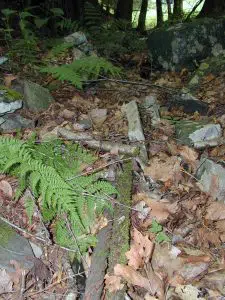
I have hundreds of images (some recently taken in August of 2005), with maps of the glen and the Shohola area on my College Web Site. Please take a few minutes and browse through the files. There are pictures of remains of the glen, images of old flyers and pamphlets that I have collected, copies of old postcards, photos and maps of the area and photographs of Jonathan, my youngest son and I, as we explored the glen. We even discovered a few old caves as we searched for the Lenni Lenape Silver Mine and found many old iron objects that we have no idea of the original purpose. We did not disturb or remove anything from the glen. I tried to take pictures from the same angle and position of the old postcards that I own. Check out the old and new views looking up the plane on the gravity railroad and you will see that it really hasn’t changed very much in 120 years.
SWITCHBACK GRAVITY RAILROAD TIMELINE
1848 – Construction of the Pennsylvania Coal Company Switchback Gravity Railroad from Hawley to the Lackawanna River near Scranton.
1882 – Construction of the standard gauge, Wyoming Division, of the Erie Railroad from Hawley to Scranton.
1885 – Abandonment of the Pennsylvania Coal Company Switchback Gravity Railroad.
1886 – Construction of the Shohola Glen Switchback Gravity Railroad from Shohola Village to Shohola Glen.
1907 – Abandonment of the Shohola Glen Switchback Gravity Railroad upper track.
1908 – Construction of Pennsylvania Coal Company industrial railroad to lumber mill along the lower Shohola Creek in the glen.
1908 – Purchase of narrow gauge locomotive from the recently abandon Delaware and Hudson gravity railroad.
1936 – Destruction and abandonment of Shohola Glen Lumber Mill and railroad due to severe flood damage.
1942 – Removal of most remaining iron and steel for war effort.
1955 – Complete destruction of the lower Shohola Glen by Hurricane Diane in August.



